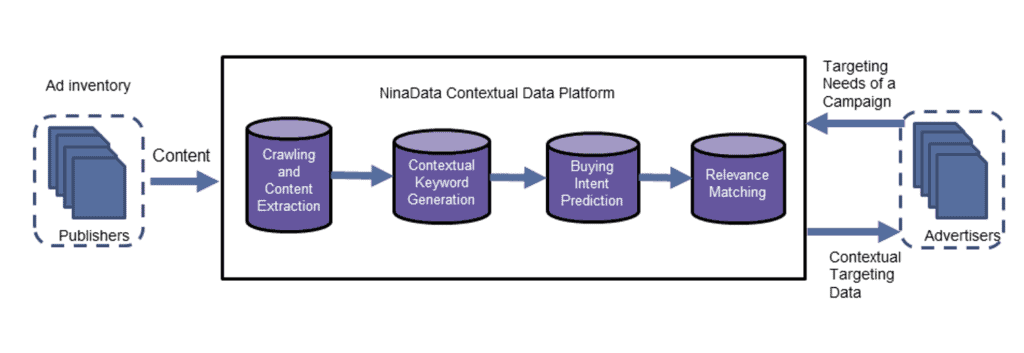Meet us at DMEXCO 2022
September 11, 2022
NLP & Contextual Intent in advertising – what are they and why are they important?
December 20, 2022Why AI-powered sentiment analysis is essential for relevant privacy-first advertising
Advertising has always been about the emotional connection – sentiment analysis can help make emotion-driven programmatic ads a reality.
Consumers have become increasingly hostile towards invasive advertising, and they are sick of being bombarded and followed around the internet with ads that are irrelevant to their interests. According to a GumGum survey, most consumers (66%) report they are uncomfortable with companies tracking their browsing history to show them personalised ads.
These worsening consumer attitudes have been a key factor in the dramatic changes to the advertising industry – namely, Google phasing out cookies by 2024 and Apple making several critical updates to become a privacy-first platform. As a result, the clock is ticking for brands and advertisers to find new ways to enable effective targeting and measurement while providing a more pleasant consumer experience.
Several solutions are available to brands to bring users relevant ads – a couple of them being sentiment and intent analysis with the power of AI. IAS research found that content with positive and neutral sentiment tends to create greater engagement. 80% of consumers were receptive to these ads, and 93% were more favourable to the ads and associated brands.
Brands have a chance to influence how their message is presented in various contexts thanks to sentiment analysis. For example, instead of avoiding a particular type of content, brands can choose how to advertise alongside the content of varying sentiments.
What is sentiment analysis?
Sentiment analysis determines the emotions and attitudes of comments, opinions, user feedback, or any other online data set. Sentiment analysis tools utilise AI to help publishers and advertisers understand how consumers react to certain topics.
Marketers employ sentiment analysis to forecast how consumers feel about their product and whether they will talk favourably or negatively about it and its competitors. Before launching a new marketing campaign, marketers can use sentiment analysis to determine whether the proposed campaign is likely to receive positive customer feedback.
Additionally, advertisers can use sentiment analysis to determine whether their campaign was effective and successful. It can also help to identify brand ambassadors or “evangelists” – people who are likely to actively spread the word on behalf of the company.
How does AI fit in the picture?
AI can now read and understand editorial and advertising content the same way as people, only on a massive scale. Known as contextual AI, it analyses text, videos, and images, considering factors such as tone and sentiment across hundreds of millions of web pages.
AI recommends web pages to advertisers that match their target audience’s interest with high probability. The predicted URLs are selected based on context relevancy. For instance, technology content is recommended for a tech brand and health or fitness-based content for health-based brands.
With NinaData, each content category is typically given a dataset between 20,000 and 30,000 hand-picked URLs as training data, manually selected to guard against any biases. This contextual AI serves as a contextual media planning tool as it allows the advertiser to determine where, when and how often to advertise in the optimal context.
AI can better interpret the emotions and sentiments behind a piece of text when the page is in a different language. Sentiment-based AI is language agnostic, and it only requires a small amount of fine-tuning for each language, making it perfect for cross-border advertising.
With the help of AI, brands and advertisers will be able to abandon demographic advertising tactics that rely on third-party cookies and begin creating contextual profiles of their customers. Instead of using cookies to track their audience, they can use artificial intelligence to analyse content and determine precisely what their audience reads in real-time.
How NinaData’s AI engine and platform works
Our technology constantly crawls millions of web pages and, by using a specific data extraction process, understands the core meaning, segmenting the pages into semantic categories. Once crawled, the page information is sent to a core engine, processed and stored in a centralised database which holds a vast amount of such information. The database is constantly growing and frequently updated.
NinaData’s platform uses state-of-the-art AI, NLP, and finely-tuned language models to achieve a high level of understanding of any web page’s intent. This allows the platform to optimise the selling of ad inventory by matching URLs to a viewer’s predicted intent based on page-level context.
This, in turn, allows advertisers, ad agencies and marketplaces to precisely target ads with 90+% accuracy without using browser cookies or any other form of personal identifiers. See how it works with the diagram below.

NinaData worked with Tap Native, crawling over 1.75 million page URLs in the USA in order to increase the company’s ROAS across multiple consumer healthcare advertising clients.
Our Buying Intent Engine recognised 350,000 URLs with > 90% relevance, meaning Tap Native achieved these fantastic results:
CTR Increased by 300%
CPC Reduced by 40%
ROAS increased by ~ 70%
If you would like to learn about how we can do the same for you, get in touch today!


